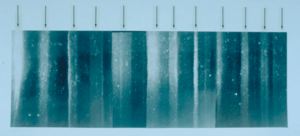Ice core facts for kids
An ice core is a long piece of ice taken from a glacier. The ice is drilled very deep, so that the ice core goes back to old ice at the bottom of the glacier. Usually, ice cores are taken from Antarctica, Greenland or very high mountains.
Snow falls on ground and accumulates (gets deeper). As more snow falls, the bottom layers get compacted (thinner) because of the weight on top. In the end, only ice remains, and all air goes away. The deeper the ice, the older it is. Ice cores can be dated by looking at the layers: often every season can be seen in the ice core because it forms a layer. At other times it is more difficult to find out how old the ice is. Other methods can be used, like measuring conductivity or making mathematical models.
Scientists study ice cores to find out how the climate was in the past. The ice keeps information like gases, particles, ash from volcanoes. The type of water that forms the ice can be used to calculate the temperature of Earth.
Ice cores help us know what the temperature was on the planet in the past 800 thousand years. We know more about ice ages that happen periodically. This is a helpful addition to our knowledge about global warming.
Images for kids
-
Sampling the surface of Taku Glacier in Alaska. There is increasingly dense firn between surface snow and blue glacier ice.
-
36Cl from 1960s nuclear testing in US glacier ice.
See also
 In Spanish: Testigo de hielo para niños
In Spanish: Testigo de hielo para niños









